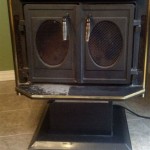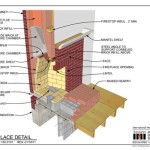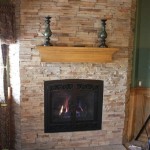```html
Outside Stone Fireplace Ideas: Enhancing Your Outdoor Living Space
An outdoor stone fireplace serves as a focal point, transforming a patio or backyard into a cozy and inviting outdoor living area. Beyond its aesthetic appeal, it provides warmth, extends the usability of outdoor spaces into cooler months, and creates a natural gathering place for friends and family. The choice of stone, design, and surrounding landscaping significantly impacts the overall ambiance and functionality of the fireplace.
This article explores various outside stone fireplace ideas, highlighting different styles, materials, and design considerations to help homeowners create the perfect outdoor fireplace to complement their landscape and lifestyle. Careful planning and consideration of local building codes are essential for a safe and aesthetically pleasing result.
Choosing the Right Stone for Your Outdoor Fireplace
The selection of stone is a crucial element in the design and construction of an outdoor fireplace. Different types of stone offer varying aesthetic qualities, durability, and suitability for withstanding outdoor elements. Popular choices include:
Fieldstone: This naturally occurring stone is characterized by its irregular shapes, sizes, and colors. It provides a rustic and natural look, blending seamlessly with outdoor environments. Fieldstone fireplaces often evoke a sense of age and timelessness. Because of its naturally varied appearance, it's important to source the fieldstone from a reputable supplier to ensure consistency in quality and manageability during construction. Properly mortared fieldstone creates a robust and long-lasting structure capable of enduring harsh weather conditions.
Flagstone: Known for its flat, layered structure, flagstone offers a more contemporary and refined appearance compared to fieldstone. It’s available in various colors like blues, reds, browns, and grays. Flagstone is commonly used for walkways and patios, making it an excellent choice for an outdoor fireplace that complements existing hardscaping. The relatively flat surfaces of flagstone simplify the building process, contributing to a cleaner and more symmetrical design aesthetic. Careful selection of flagstone pieces ensures minimal gaps and a cohesive, visually appealing surface.
River Rock: Smooth, rounded stones collected from riverbeds impart a unique and organic texture to an outdoor fireplace. River rock adds a touch of natural elegance and works well in designs that prioritize soft lines and curves. The different sizes and colors of river rock create a visually interesting mosaic effect. The smooth surface of river rock requires specialized mortar techniques to ensure proper adhesion and stability. The selection process should focus on uniformity in size and color to maintain a consistent and balanced aesthetic.
Ledgestone: This type of stone consists of thin, stacked pieces, providing a sleek and modern look. Ledgestone fireplaces are often used in contemporary designs and offer a clean, linear aesthetic. The consistent size and shape of ledgestone simplify the installation process, resulting in a streamlined appearance. Ledgestone is typically available in manufactured and natural options, each providing varying degrees of durability and weather resistance. Proper installation, including appropriate sealing, is critical to prevent water damage and ensure the longevity of the ledgestone fireplace.
Manufactured Stone Veneer: As an alternative to natural stone, manufactured stone veneer offers a cost-effective and versatile option. It is made from concrete and molded to resemble various types of natural stone. Manufactured stone veneer is lighter than natural stone, making it easier to install, and it's available in a wide range of colors and textures. Although it mimics natural stone, it may not possess the same level of durability and weathering characteristics. However, advancements in manufacturing have improved the quality and realism of manufactured stone veneer, making it a popular choice for budget-conscious homeowners. Properly installed and maintained manufactured stone veneer can provide a visually appealing and long-lasting outdoor fireplace.
Design Considerations for Your Stone Fireplace
Beyond the choice of stone, several design considerations play a crucial role in creating a functional and aesthetically pleasing outdoor fireplace. These include:
Size and Scale: The fireplace should be proportional to the surrounding outdoor space. A large fireplace in a small patio may overwhelm the area, while a small fireplace in a large backyard might appear insignificant. Consider the size of the seating area and the overall layout of the outdoor space when determining the appropriate dimensions of the fireplace. A well-proportioned fireplace will blend seamlessly with the surrounding environment and enhance the overall aesthetic appeal.
Style and Architecture: The style of the fireplace should complement the existing architecture of the house and the overall landscaping design. A rustic fieldstone fireplace might suit a traditional home, while a sleek ledgestone fireplace might be more appropriate for a modern residence. Consider the existing color palette, materials, and architectural details when selecting the style and design of the fireplace. A cohesive design will create a unified and harmonious outdoor living space.
Fireplace Features: Incorporating additional features can enhance the functionality and aesthetic appeal of the outdoor fireplace. Some common features include:
Wood Storage: Built-in wood storage provides a convenient and accessible place to store firewood, keeping it dry and organized. Wood storage can be integrated into the design of the fireplace, creating a seamless and functional element. The size and location of the wood storage should be considered based on the frequency of fireplace use and the available space.
Mantel: A mantel provides a decorative surface for displaying objects or adding visual interest. The mantel can be made from stone, wood, or other materials that complement the overall design of the fireplace. Consider the size, shape, and material of the mantel to ensure it enhances the aesthetic appeal of the fireplace without overwhelming the design.
Seating: Built-in seating around the fireplace creates a cozy and inviting gathering space. Stone benches or seating walls can be integrated into the design, providing comfortable and durable seating options. Consider the number of people you want to accommodate and the overall layout of the seating area. Comfortable cushions and throws can add to the comfort and visual appeal of the seating area.
Grill or Pizza Oven: Integrating a grill or pizza oven into the fireplace design adds cooking functionality, making it a versatile outdoor feature. This option transforms the fireplace into an outdoor kitchen, allowing for outdoor cooking and entertaining. Consider the size and type of grill or pizza oven and ensure proper ventilation for safe and efficient operation.
Planning and Construction Considerations
Before embarking on the construction of an outdoor stone fireplace, careful planning and consideration of building codes are essential. These considerations ensure a safe, functional, and compliant structure.
Local Building Codes: Research local building codes and regulations regarding outdoor fireplaces. These codes may specify requirements for setbacks, height restrictions, chimney construction, and fire safety measures. Obtain the necessary permits before starting construction to ensure compliance with local regulations. Failure to comply with building codes can result in fines and delays.
Safety Precautions: Prioritize safety throughout the design and construction process. Ensure that the fireplace is located away from flammable materials, such as trees, shrubs, and fences. Install a spark arrestor on the chimney to prevent sparks from escaping and potentially causing a fire. Use fire-resistant materials for the construction of the fireplace and surrounding area. Keep a fire extinguisher nearby and ensure that all users are aware of fire safety procedures.
Professional Installation: Consider hiring a professional contractor experienced in outdoor fireplace construction. A professional contractor can ensure proper design, construction, and compliance with building codes. They can also provide valuable insights and recommendations based on their experience. Proper installation is crucial for the safety and longevity of the fireplace.
Ventilation: Proper ventilation is crucial for efficient combustion and to prevent the buildup of harmful gases. Ensure that the chimney is properly sized and constructed to allow for adequate airflow. Consider incorporating vents or dampers to control the airflow and regulate the intensity of the fire. Poor ventilation can result in smoky fires and potential health hazards.
Foundation: A solid and stable foundation is essential for supporting the weight of the stone fireplace. The foundation should be constructed of reinforced concrete and extend below the frost line to prevent cracking and shifting. The size and depth of the foundation will depend on the size and weight of the fireplace. A properly constructed foundation will ensure the stability and longevity of the structure.
By carefully considering these design choices and construction considerations, homeowners can create an outdoor stone fireplace that enhances their outdoor living space and provides years of enjoyment.
```
Outdoor Fireplace Design Ideas Getting Cozy With 10 Designs Unilock

30 Outdoor Fireplace Ideas Cozy Fireplaces

53 Most Amazing Outdoor Fireplace Designs Ever Chimeneas Diseño De Chimenea Cocina Al Aire Libre

Amazing Fire Pit Outdoor Fireplace Ideas Natural Brick Stone Depot

Natural Stacked Stone Veneer Fireplace Ideas

Natural Stone Outdoor Fireplace Ideas Photos Houzz

Outdoor Fireplace Trends Environmental Designs

21 Outdoor Fireplace Ideas For A Cozy And Inviting Backyard

45 Beautiful Outdoor Fireplace Ideas Install It Direct

Outdoor Fireplace Design Ideas








